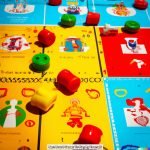Introduction
20 Questions Board Game is an enjoyable and witty game of strategy and luck. In the game, one player attempts to guess an object thought of by another player in up to 20 questions. The guessing player has the opportunity to gain knowledge about the object by asking either yes-or-no questions or general questions about the object’s characteristics or functions. If a player can guess accurately within 20 questions, then they win!
Setup:
Before players can start playing Twenty Questions, they have to prepare for the game. To set up each round, one person must be chosen as the “thinker” who will think of an object without any physical props. Once this is determined, all other players become the “questioners” who are responsible for asking the thinker up to 20 questions that involve yes-or-no answers or general information regarding an object’s characteristics or functions. After each question, the thinker is given only a few seconds to answer before it is passed onto another questioner.
Scoring and Play:
Once all players are familiar with the rules and are ready to begin play, they will start on their first round with a fresh thinker and round of questioning. The goal is for a questioner to correctly guess what object the thinker is thinking of before twenty questions have been asked. If a successful guess has not been made after 20 questions have been asked, then none are awarded any points for that round. If someone successfully guesses sooner than 20 turns, then they get 5 points per turn remaining in that round!! At the end of each successful guessing match, different players become thinkers while other continue in their roles as questioners until all rounds have concluded and scores are tallied up declaring one by one which player wins overall!
History of the Game
20 Questions is a time-tested guessing game that has been around for centuries. It is also known as “The Name Game” or “Animal, Vegetable, or Mineral.” The objective of the game is to guess which person, place, animal, thing, or idea the other player(s) is thinking of.
Players will gather in pairs or a group and one person will nominally begin by thinking of any person, place, animal, thing, or idea. The other players must then take turns asking yes/no questions that can be answered with either “yes” or “no” in order to get closer to the correct answer. The greatest challenge of the game lies in phrasing questions that are narrow enough to give helpful clues about the mystery subject without being too obvious. On average it usually takes about 20 questions until someone is able to come up with their guess and make an accurate reveal.
Although the version we know today has become popular more recently due to modern technology, 20 Questions has its roots reaching way back into Ancient Greece when it was first played over 2000 years ago by Plato and his students as an academic exercise. Since then this classic guessing game has gone through many iterations around the world which can be observed in variations like: Möbisbolle (Swedish), Chicca (Italian), Ty Burna (Welsh), Yes Boss (Hindi), and Blödelspiel (German). Each version may differ slightly on rules such as how many guesses are allowed per round or how much time someone gets for questioning but all forms ultimately involve getting smarter tell us their questioner’s thought using deduction from clues given exclusively by word-based responses.
Game Setup
The 20 Questions board game is a classic guessing game, first created in the late 1940s. It’s easy to set up and fun for all ages.
To get the game going, one player should choose a card before play begins that contains an object with its picture displayed. This is the person who will be guessed by their opponents. The guesser picks a card without letting the other players see it and puts it in front of them, face down. Then everyone else will take turns asking questions about what the object might be.
Once 20 questions have been asked among all players, then the guesser must reveal what they have chosen and if they were guessed correctly! To make things more challenging, any player can earn additional points if they are able to guess the object within five questions! The player who accumulates the most points throughout multiple rounds wins the game!
Introducing the Players
The 20 Questions board game requires three players to play. There is a Questioner, an Answers person, and Guesser.
The Questioner’s job is to think of a mystery object ” such as an animal, thing, or person ” that the others do not know about. The Questioner will then give the Answers person hints or questions about the mystery object until it has been guessed correctly by the Guesser.
On the other hand, the role of the Answer person is to provide truthful answers in response to each question posed by the Questioner. The Answer person can’t explain directly what they are thinking of but instead need to offer clarifications through their responses.
Finally, it is up to the Guesser to use his/her deductive reasoning skills and recently received clues from the Questions and Answers people in order to figure out what exactly it is that they are thinking of. If after twenty questions asked by the Questioner no answer has been given by either player then everyone loses and must start over with a new mystery item chosen by another player.
Rules & Gameplay
Object of the Game:
Players take turns trying to guess a person, place, or thing selected by another player (the answerer). The other players are the guessers and they can only ask yes/no questions.
Setup:
The answerer must select an object secretly, without revealing it to anyone else. They will be in charge of the game board and keeping track of the number of questions that have been asked.
Gameplay:
Once the secret object has been chosen, the game can begin! The first player gets to ask a yes/no question about the object and then going around in a circle, each player will get a chance to ask one question at a time. If none of the players correctly guess after 20 questions have been asked (or before), then the answerer reveals what their object was. If someone guesses correctly during this round, they’re awarded as the winner!
Strategic Decisions
20 Questions is a classic game of guessing an adversary’s secretly selected item by asking a series of yes or no questions. One player chooses an object, which the other players then have to guess. To maximize your chances of winning 20 questions, you should ask questions that are more likely to discover what the object isn’t than what it is. This type of questioning can help to narrow down the field and eliminate possibilities until you get closer to the correct answer. Additionally, make sure your questions don’t give too much away as this may give your opponents some clues they can use against you. You should also think outside the box when it comes to choosing potential answers; avoid any pre-conceived notions about certain types of answers and be creative in forming your inquiries. Additionally, if your opponents are stuck, don’t forget to mention objects around you or ones that couldn’t already be guessed; this might spark an interesting discussion and even jog someone’s memory about something else entirely related but previously forgotten! Finally, pay close attention to your opponents’ every move; take note of what responses they are giving for specific items and utilize that information for future rounds “” this tactic could be key in helping you win!
Variations & Ideas
The 20 Questions Board Game is based on the popular game of questioning “yes” or “no” answers. Players take turns asking questions with the goal of guessing what the other players are thinking with only 20 questions (or fewer) asked by each person. The game is easy to learn and fun to play, but here are a few creative ideas to make it even more enjoyable:
1. Change the topics or categories for each round, such as “Animals” or “Holidays”.
2. Set a timer for each round so players have to think quickly and ask many questions in quick succession – whoever guesses correctly first wins the round!
3. Add an extra layer of challenge by having players keep track of their own tally and also guess who they think everyone else is thinking of during their turn ” if they guess everyone else’s thoughts correctly they get double points!
4. Spice it up by dividing into teams and competing against one another with a larger number of questions per turn so that one team can be eliminated before the conclusion of the round.
5. At the end of each round, give bonus points for whoever comes up with the most creative description on an answer to one of their questions ” it adds an element of surprise when trying to guess what others may be thinking!
Alternative Platforms
The classic 20 Questions game takes a unique spin on the traditional game of questions and answers. Players take turns asking others “yes” or “no” questions in an attempt to guess a selected person, place, thing, theme-word, or random fact. The goal is for the questioner to guess the answer correctly in twenty questions or less.
Due to its simple nature, this game has been adapted from its traditional format into digital versions that allow players from all around the world to join in. Instead of writing out their guesses or questions on a piece of paper or passing around cards, gamers can simply go online and start playing with minimal setup requirements. These digital versions usually run on websites or through downloadable apps. Sometimes these platforms will have public lobbies where anyone can join in for quick one-off games, but often private games are also available so that friends can challenge each other without interruption. Additionally, most providers also include helpful features such as score tracking and scoreboards so that players can more easily follow how well they’re doing compared to everyone else playing at any given time. Digital versions of 20 Questions are fun and entertaining while still providing the same challenge as its traditional version ” with the added convenience of being able to play it anytime you’d like!
Closing Thoughts
The 20 Questions board game is a great way to have fun and spur lively discussion among family and friends. It’s easy to learn the rules, making it a perfect game for young children and seasoned players alike. As you sit around with friends, seeing how quickly each person can solve the puzzles as 20 questions gets asked prompts well-thought out strategizing and creative problem solving.
What’s more, 20 questions unknowingly serves a higher purpose ” to develop interpersonal skills and socialization in those who play it regularly. Being forced to think critically while interacting with other people in order to answer the puzzling questions encourages players of all ages to build strong relationships with each other, use empathy when asking questions, and think laterally to come up with potential solutions. This type of personal development cannot be underestimated.
As an energizing and enjoyable pastime, this simple yet stimulating board game stands the test of time regardless of age or generation. Based on its ability to bring people together while improving their communication skills, it is clear that this classic game remains relevant today!
Conclusion
Playing 20 Questions board game is an incredibly fun, interactive way to connect with friends and family members. Not only is it enjoyable, it’s also a great way to increase your mental sharpness by using deductive logic, help build relationships and social skills through communication, and exercise problem-solving skills by thinking critically when questioning. Additionally, 20 Questions is a great way to improve knowledge across multiple topics including science facts, animals, books and music. The game has been popular for hundreds of years because it provides an opportunity for players from all ages and backgrounds to have fun together while simultaneously exercising their minds.

I love playing all kinds of games – from classics like Monopoly to modern favourites like Ticket to Ride.
I created this blog as a way to share my love of board games with others, and provide information on the latest releases and news in the industry.





